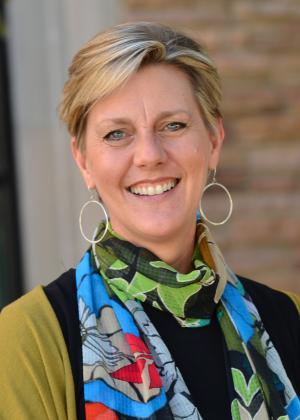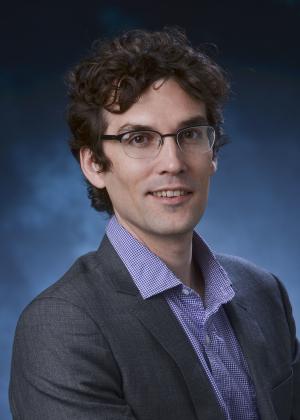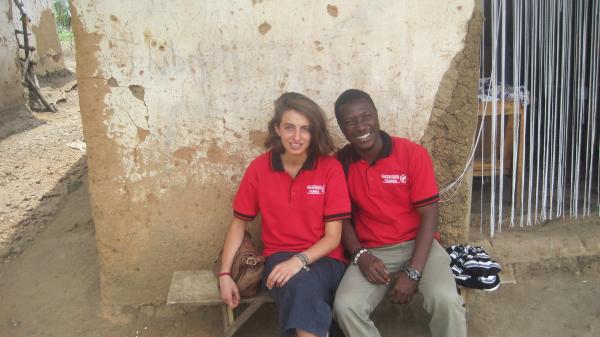Lori Hunter, Director of the CU Population Center and the Population Program at IBS, has received an appointment to serve on the National Academy of Sciences Board on Environmental Change and Society (BECS). The BECS helps guide research in the United States on the interactions between human activity and global environmental change. It is the mission of the BECS to increase problem-focused understanding of coupled human-environment systems, and to inform transition to improved human well-being in the face of environmental change. Some of the recent reports produced by the BECS include Valuing Climate Damages: Updating Estimation of the Social Cost of Carbon Dioxide (BECS 2017) and Accomplishments of the U.S. Global Change Research Program (BASC, BECS 2017). Dr. Hunter’s expertise on human-environment interactions and the energy she brings to all of her projects will surely prove to be assets to the current and future projects of the Board. Her areas of expertise combined with her history of leadership and service prompted her nomination to the BECS by IBS Director Myron Gutmann, who served on the precursor to the BECS, the former Committee on the Human Dimensions of Global Change. This is one of the many ways IBS researchers give service to the public.
News
All news items, blog posts, and feature stories.
Lori Peek Featured in NYT Article About Hurricane Recovery
An article entitled "Life after the Storm: Children Who Survived Katrina Offer Lessons" was published on September 8th by the New York Times. Dr. Lori Peek, the director of the Natural Hazards Center at IBS, did extensive research on the ground in New Orleans in the years that followed Katrina and published a book on her findings entitled "Children of Katrina", which she co-authored with Dr. Alice Fothergill of the University of Vermont.
Here is a brief excerpt from the article:
"In the years after Katrina, a pair of sociologists, Alice Fothergill and Lori Peek, made regular trips to New Orleans, interviewing hundreds of people who had been hit hard and tracking their lives over time, checking in repeatedly. After seven years, the pair identified a rough pattern among displaced children: some had not regained their footing, losing years of schooling and later sinking into unemployment; others adapted, even thrived; and there was a third group, of young people in an uncertain holding pattern, keeping themselves upright but unsteadily, managing lingering effects, like depression or anxiety.
Those in the first group tended to have few resources to start with, and lost them all. “It’s a cumulative vulnerability, in which for instance the family struggled before the storm, then could not get out, and the child lost the fragile supports he or she had,” said Dr. Fothergill, a professor at the University of Vermont.
Dr. Peek, a professor at the University of Colorado, said that those children who adapted fastest typically had family and networks with resources that held together through Katrina, or acquired strong allies along the way: teachers, pastors, shelter workers who fought for help on the child’s behalf.
The third group – “fluctuating equilibrium,” the sociologists called it – usually had lost virtually everything but had one solid anchor: a mother, a father, a teacher, an older sibling.
The rest of the article can be reach here: https://www.nytimes.com/2017/09/08/health/katrina-harvey-children.html?_r=0
IBS Researchers Land Funding for Advanced Study of Gene-Environment Interactions
Postdoctoral researchers and doctoral students to increase their knowledge of demography and genetics in one of the first programs of its kind
Article by Jeff Thomas
Jason Boardman has made headlines studying the interactions between people’s genes and their environment, finding, for instance, that social factors trump genetic forces in forging friendships. Now, the University of Colorado Boulder sociologist is helping to launch an advanced training program, one of the first of its kind in the nation, to train young scholars in this cross-disciplinary field.
The National Institute on Aging has awarded Professor Boardman, from CU Boulder’s Institute of Behavioral Science (IBS), and Professor Michael Stallings from CU Boulder’s Institute for Behavioral Genetics (IBG), $595,666 over three years, to create a formal training program in the area.
Boardman was a tenure-track assistant professor in sociology at the University of Colorado Boulder in 2005 when he decided to expand his research in social demography, or the statistical study of human populations, to include behavioral and statistical genetics. “Essentially, I had to take graduate level studies in these areas,” Boardman said. “I didn’t have much of a background in many of those fields, so I was raising my hand a lot.”
Boardman decided to look at the intersection and interaction between social factors — such as where one lives or works or whom one socializes with — and genetic factors as both influence complex health behaviors, such as smoking. He has published on this topic extensively, and beginning next year, like-minded post- and pre-doctoral students will be able to as well in the new training program.
Boardman’s genetic research has previously been supported by a five-year award from the Eunice Kennedy Shriver National Institute of Child Health and Human Development in the National Institutes of Health. This grant allowed Boardman to maintain his position as a faculty member but spend nearly half of his time studying genetics with researchers at IBG.
Leaders of both IBS and IBG hailed the award:
“This is a tangible vote of support at the national level for the successful collaboration between IBS and IBG,” John K. Hewitt, director of IBG, said. “It reaffirms the value of our efforts to develop innovative interdisciplinary graduate and postdoctoral training programs.”
"This new grant demonstrates the leadership that Jason has achieved in connecting social and behavioral science with a deep understanding of genetics, something that draws on the outstanding expertise of the two institutes and amplifies our ability to train the next generation of researchers," Myron P. Gutmann, director of IBS, added.
Demography and genetics postdoctoral researchers and doctoral students will be annually funded by the grant over three years to increase their respective knowledge of demography and genetics —demographers will study behavioral genetics, and behavioral geneticists will study demography.
Three postdoctoral researchers, two of whom received support from NIH, have recently taken similar paths at the two research institutes, and have all been involved with innovative research projects, leading to tenure-track positions at leading universities.
Benjamin Domingue is now an assistant professor in the Graduate School of Education at Stanford University. During his time as a postdoctoral researcher with Boardman, he was supported by several funding mechanisms in an ad-hoc manner. The goal of this new program at CU Boulder is to replicate the training that Domingue received but in a more formal manner. Brooke Huibregtse, the first postdoctoral researcher appointed to the training program, said she is excited about the opportunity to integrate new approaches with her formal training in psychology.
“Investigating genetic risk factors is only one side of the coin; it is important to also consider the social context in which complex health behaviors develop,” she said. While there are now numerous research articles expanding on the study of the interaction between genes and environment, there is not a permanent training program today, according to Boardman. Reviewers noted that the strength of research from both the IBS and IBG, as well as researchers from CU Denver, was a significant factor in the decision to locate such a program at CU.
“This is an important indication that reviewers and NIH see this as the place to go to receive this very unique training,” Boardman said. “This training program will enable the next generation of scholars to tackle complex public-health issues such as increasing rates of obesity, individual differences in stress sensitivity, and complex and comorbid substance-use disorders with innovative and cutting-edge approaches.”
According to the proposal, IBS faculty members have expertise in areas that could not easily be duplicated by other research institutes, including the intersection of people’s genetics and their environment and its role in health outcomes, patterns of HIV/AIDS in Africa and healthy adolescent development.
“IBG has an incredibly strong and international reputation in research on genetic factors linked to different behaviors across the life course,” Boardman said. IBG “hosts annual workshops on twin modeling and advanced statistical genetics that are among the most popular courses on this topic in the country. Indeed, following a comprehensive external evaluation of IBG, one reviewer commented that IBG is, ‘a world leader that is unique in its extensive combination of human and animal model research studies of human behavioral variation.’”
Boardman said faculty members are still determining whether to offer an academic certificate for the program. Meanwhile, the interaction between IBS and IBG researchers continues to lead to interesting studies, including “wet lab” scientists such as IBG’s Tom Johnson, who studies molecular behavioral genetics using worms and mice.
“It’s amazing what comes up when we’re all together talking about this,” Boardman said.
This article was originally publoshed on CU's A&S Magazine. The original article can be read in it's entirety here.
IBS Researchers Honored with 2017 SPAIG Award
At the recently concluded Joint Statistical Meeting of the American Statistical Association, IBS researchers Seth Spielman and David Folch were recipients of the 2017 Statistical Partnership Among Academe, Industry, and Government Committee (SPAIG) Award for their work wiht the National Science Foundation – Census Reserach Network (NCRN). IBS Director Myron Gutmann was also honored for his role in the creation of the NCRN. Established in 2011, NCRN has been a highly successful collaboration between multiple universities and the U.S. Census Bureau. It aimed to provide support for conducting interdisciplinary research and educational activities on methodological questions of significance to the broader research community and to the federal statistical system.
This collaboration has won the SPAIG Award due to its broad impacts based on many NCRN research activities over the past six years. The SPAIG Committee was impressed by the diverse achievements including, the novel method that significantly improves the accuracy of the tabulations from the Economic Census, the production of synthetic business micro-datasets, and the effective training of the next generation of statisticians.
The SPAIG Award, established in 2002, is sponsored by the SPAIG committee of the ASA to recognize outstanding partnerships between academe, industry, and government organizations, as well as to promote new partnerships among these organizations. The award is distinct from other ASA awards in that it recognizes outstanding collaborations between organizations, while recognizing key individual contributors.
IBS Health and Society Program Study on Mortality Rates Published in IJE
Opioids, obesity—not 'despair deaths'—raising mortality rates for whites
Drug-related deaths among middle-aged white men increased more than 25-fold between 1980 and 2014, with the bulk of that spike occurring since the mid-1990s when addictive prescription opioids became broadly available, according to new CU Boulder research. The study, published online today in the International Journal of Epidemiology, also found that, contrary to widely reported research findings, suicide and alcohol-related deaths are not to blame for increasing mortality rates among middle-aged whites.
The results call into question recent reports suggesting that what have become known collectively as “despair deaths”—by suicide, alcohol and drugs—are on the rise among white Americans, particularly men, facing a lack of economic opportunity and an increase in chronic pain. “We find little empirical support for the pain-and distress-based explanations for rising mortality in the U.S. white population,” said lead author Ryan Masters, an assistant professor of sociology at CU’s Institute of Behavioral Science. “Instead, recent mortality increases have likely been shaped by the U.S. opiate epidemic.”
Masters said metabolic diseases, including heart disease, obesity and diabetes, are also playing a key role. After years of declining death rates for such diseases, thanks to new drugs and procedures, that progress has slowed for men and stalled for women, the study found. “When it comes to mortality, we are just starting to see the real health consequences of the obesity epidemic,” he said.
Masters, along with graduate students Andrea Tilstra and Daniel Simon, launched the study in spring 2016 after papers revealed, following years of decline, U.S. mortality rates had begun to inch up among middle-aged white non-Hispanic men and women. Follow-up studies suggested such increases were disproportionately driven by chronic liver disease, suicide and overdoses, which some suggested were “symptoms of the same underlying epidemic” of emotional distress, economic insecurities and chronic pain. One study published in 2015 in the Proceedings of the National Academy of Science referred to “despair deaths” among a “lost generation whose future is less bright than those who preceded them.”
“The despair death narrative caught fire and has since begun to inform mortality research and media coverage, and shape dialogue among policymakers and politicians. Yet our research shows it is demonstrably incorrect,” Masters says. For the new study, he looked at U.S. mortality data from the National Center for Health Statistics, the Centers for Disease Control and Prevention, and U.S. Census Bureau for U.S. non-Hispanic white men and women age 25 to 34 and 35 to 54 from 1980 to 2014. While previous research had lumped men and women, 10-year age spans, and drug, alcohol and suicide deaths together, Masters and his team disentangled the datasets, looking independently at genders, individual year ages and distinct causes of death. They also distinguished between “period effects” in which shifts in mortality rates were similar among all age groups, and “cohort effects” in which the shifts were unique to individuals born in a particular time frame.
One glaring pattern emerged. Among men and women of all age cohorts studied, drug-related deaths have skyrocketed. For instance, in 1980, 1.4 per 100,000 men and 1.76 per 100,000 women died from drug overdoses. By 1998, those numbers had climbed to 9.5 for men and 3.6 for women. By 2014, they’d risen to 36.5 for men and 24.4 for women. Meanwhile, the researchers found “no substantive increases in white men’s alcohol-related mortality at any time.” Suicide rates did rise slightly between 1999 and 2014 for men and women. But this was due largely to spikes among all age groups during times of economic downturn. “This suggests that economic insecurities are not isolated to a single ‘lost generation,’” said Tilstra.
With drug-related mortality rates, “It took off around the time when prescription opioids became readily available, and it has kept rising steadily ever since,” Masters says. The team, in yet-to-be published research, has also looked at the numbers for black men and black women and has seen similar patterns of soaring rates of drug abuse across age cohorts since the late 1990s.
“We do not doubt that times of economic insecurity can have severe consequences for a population’s health, nor do we doubt that pain and distress can pose serious health problems,” the authors conclude. “However, taken together, our findings suggest that it is unlikely that recent trends in U.S. white men’s and women’s mortality rates have been driven by an epidemic of pain and rising distress.”
Instead, the authors point to over-prescription and misuse of opioid-based painkillers, heroin use, and an “obesogenic” environment. They hope their paper will encourage policymakers and researchers to explore those drivers and their solutions further.
This article was originally published by CU Today. The original can be found here.
IBS Group Receives SFPRF Large Research Grant
A group of IBS Researchers, led by Amanda Stevenson with co-investigators Jane Menken, Stephanie Mollborn, Sara Yeatman, and Katie Genadek, were recently awarded funding on a large research proposal from the Society of Family Planning Research Fund (SFPRF). The project, entitled Assessing life course impacts of expanded access to LARCs in Colorado, asks the question "Does access to high quality family planning positively affect the life course of women and their families?". Stevenson's group plans to address this question, an area of research that is cruicial to policy arguments worldwide yet has rarely been studied with adequate data on the life course outcomes of the women family planning programs are intended to assist.
The study will assess the medium-term multi-dimensional life course consequences of improved access to contraception, focusing initially on exposure to the Colorado Family Planning Initiative (CFPI) during adolescence and the transition to adulthood (ages 15-24). Beginning in November 2009, CFPI provided provider training and free or dramatically reduced-cost LARC devices to all Title X clinics in Colorado (but not surrounding states), presenting a unique opportunity to assess the impacts of expanded access to these highly-effective methods. The project will take advantage of recent Federal decisions permitting the US Bureau of the Census to link many years of individual administrative records across a variety of sources and provide restricted access to these records for approved research. The data developed in partnership with the Census Bureau will provide a unique opportunity to assess how and to what extent women’s life courses were affected by expanded access to LARC during a critical period of life.
IBS Study: When Farmers Must Pay for Groundwater, They Cut Use by a Third
This article was originally published in CU Boulder Today. You can view the original article here.)
By: Lisa Marshall
With record high temperatures scorching the Southwest this week, farmers were quickly reminded of the severe droughts that threatened their crops and livelihood in recent years. How will they manage increasingly scarce water when drought comes again? A new CU Boulder-led study suggests that self-imposed well-pumping fees can play an important role, incentivizing farmers to slash use by a third, plant less thirsty crops and water more efficiently.
When we talk about groundwater crises arising all over the world, the knee-jerk reaction among policymakers is often to ask, ‘What can government do?’ not ‘What can farmers do?’,” said Krister Andersson, director of the Center for the Governance of Natural Resources at CU Boulder's Institute of Behavioral Science and co-author of the paper in the Journal of the Association of Environmental and Resource Economists. “This study shows that there exists a good alternative to top-down regulations—that self-organized efforts can have a huge impact on how much water farmers use.”
The study centered around a novel initiative in Colorado’s San Luis Valley, where several hundred farmers voted to self-impose a fee on groundwater—which is typically free and largely unregulated—beginning in 2011. The move came after a historic drought in 2002 and subsequent dryer-than-average years left the region’s aquifer depleted and some farmers worried that the state might begin shutting down wells, as it had in other areas. Historically, farmers have relied primarily on surface water from streams and run-off, but as population growth and climate change have strained supplies, agriculture has grown increasingly reliant on water pumped from underground.
The new fee, now at $75 per acre foot of water, is among the first in the nation. About 700 farmers who manage 170,000 acres are subject to the fee. Proceeds are used to help local irrigators buy supplemental surface water or to pay them to let their acreage go fallow, or unused, in dry years. As part of a National Science Foundation grant aimed at assessing self-organized water conservation programs, CU Boulder researchers have spent years in the San Luis Valley Basin meeting with stakeholders and collecting data.
“With this study, we have been able to offer validation that what they are doing is working,” said co-author Kelsey Cody, a graduate research assistant in CU Boulder’s environmental studies program. The study drew upon five years of data from farmers inside and outside the fee district before and after it was implemented. It found that farmers subjected to the fee pumped 32 percent less water per year on average. Some switched to less water intensive crops. Others upgraded to more water-efficient irrigation equipment. Notably, some did not reduce their water use at all and instead opted to pay extra.
“This is because a fee does not prescribe what one can and cannot do; it just forces the irrigator to consider the cost of the water itself,” notes lead author Steven Smith, who did the research as a doctoral student at CU Boulder and who is now an assistant professor of economics at Colorado School of Mines. The authors stress that while the study confirms that irrigators are using less water and changing their farming practices, more research is necessary to determine how the fee has impacted them financially and whether the fee has caused the aquifer to recharge. Another study is in the works.
Despite wetter weather in the past year, the participating irrigators intend to keep the fee in place, and other nearby districts are moving to implement a similar one, said Cleave Simpson, general manager of the Rio Grande Water Conservation District, which helps facilitate the fee. “We are cautiously optimistic about it.”
As lawmakers in California, Texas, and other states ponder ways to regulate groundwater use, the researchers hope what’s happening in the San Luis Valley can serve as a lesson. The authors stress that a self-imposed groundwater fee may not be appropriate for all agricultural areas, but as the state looks for ways to conserve groundwater, it could be one effective tool. “The punchline here is that irrigators are far more responsive to these price mechanisms than was previously believed,” said Smith. “Through their adoption, they may be able to induce a lot of conservation.”
Former IBS Research Assistant receives APSA’s Leonard D.White Award
Former IBS Reserach Associate in the Environment & Society Program, Alan Zarychta, is the recipient of the American Political Science Association's 2017 Leonard D. White Award which is awarded annually for the best dissertation successfully defended during the previous two years in the field of public administration. The award committee included Zachary Oberfield (Haverford College), chair, Mary Feeney (Arizona State University) and Holly Goerdel (University of Kansas). Alan produced and defended his dissertation at CU Boulder and he continues to work with IBS researchers in both the Environment & Society and the Population programs.
PhD candidate studies fertility, maternal health in Tanzania
University of Colorado Boulder doctoral candidate Adenife Modile, who studies fertility and maternal health worldwide, travels to Tanzania this month as a Population Reference Bureau fellow. His aim, in the long term, is disrupting the assumption that “having lots of kids is what we do.”
The summit in Dar es Salaam, Tanzania, is the first stage of the Policy Communications Fellows Program, a one-year fellowship designed to help researchers like Modile better understand how their research can inform social policy.One of 10 people from seven countries selected for the fellowship, Modile wants to influence public policy to disrupt cultural norms that encourage high fertility rates.
Modile explores fertility trends by analyzing data sets from more than 200 countries. He has researched the effects of origin family size, availability of natural resources, father involvement and racism on “fertility intentions” and maternal health in African countries and the United States. In Madagascar, he researched the variability of women’s fertility intentions, or how many children a woman wants to have, from region to region, analyzing the effects of natural obstacles and barriers on women’s healthcare.
“Our study found that higher levels of local natural resources are associated with lower desired family size. In other words, scarcity is linked to higher desired fertility,” Modile says. One explanation for this may be that children provide necessary labor in regions with limited resources and challenging livelihoods.
Furthermore, women who experience more seasonal variation in resource availability tend to have lower fertility intentions, indicating that “children’s labor may be particularly important in regions with consistent availability of natural capital,” Modile says.
In Nigeria, he studied the relationship between a woman’s nuclear family size as a child and her ideal family size when she grows up: what Modile calls “intergenerational transmissions of fertility intentions.” He has found that origin family size is linked with one's ideal number of children. This means that a woman with five siblings is slightly more likely than a woman with two siblings to report five children as her ideal number of children.
But Modile wonders whether women consistently report their actual ideal numbers, and how husbands influence those reported numbers. “Is this [survey] a true measure of a woman’s wish?” he asks. “What’s the role of men in childbearing intentions?”
Modile also wants to examine the role of men in women’s healthcare. He sees a need for more cutting-edge quantitative research regarding the role of men in maternal health, especially using under-utilized data sets. “Men act as important social determinants in their partners’ accessing healthcare services. Male involvement is an important factor in improving maternal health and reducing maternal mortality rates,” Modile says.
He wants to know more about the role of men in their partners’ prenatal health care and how “men’s attendance in prenatal care affects fertility outcomes.” Modile’s research in the United States explores racial disparities in life satisfaction and overall health of white women and black women during pregnancy.
Data from the Behavioral Risk Factor Surveillance System suggest that during pregnancy, women generally enjoy increases in life satisfaction, but not equally. Even when controlled for education and income, “non-Hispanic black pregnant women did not really increase to the levels of white women’s life satisfaction.”
Drawing on work by University of Michigan sociology Professor Arline Geronimus, Modile suggests that the cumulative effect of racial disparity and discrimination in everyday interactions dramatically affects the ways in which women think about their health.
He is interested in the ways racial health disparities contribute to this, as well as how these differences relate to birth outcomes. “Everyday racism can create problems in how women think about their living conditions and recreational facilities, which can impact how they rate their physical and mental health,” he says.
Modile plans to use his communications fellowship to influence policy in sub-Saharan African countries and around the globe. His goal is to increase access to reproductive health services, to lower fertility rates globally and to “break the idea that … having lots of kids is what we do.”
This begins with increasing education levels, especially among women, so that women are more involved in decisions beyond the household, Modile says. Yet he is realistic about effecting change in sub-Saharan Africa. “Even when sociologists and health experts see places where things need to change, it can be difficult to get interventions to stick.” Identifying the beneficiaries and stakeholders of these health interventions is one important step.
With good communication between scientists and government officials and by starting in smaller communities, Modile believes he can achieve tangible, lasting results.
This article was originally published by Colorado Arts and Sciences Magazine. You can find the original atricle in its entirety here.









